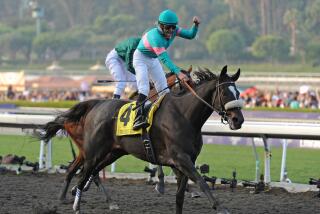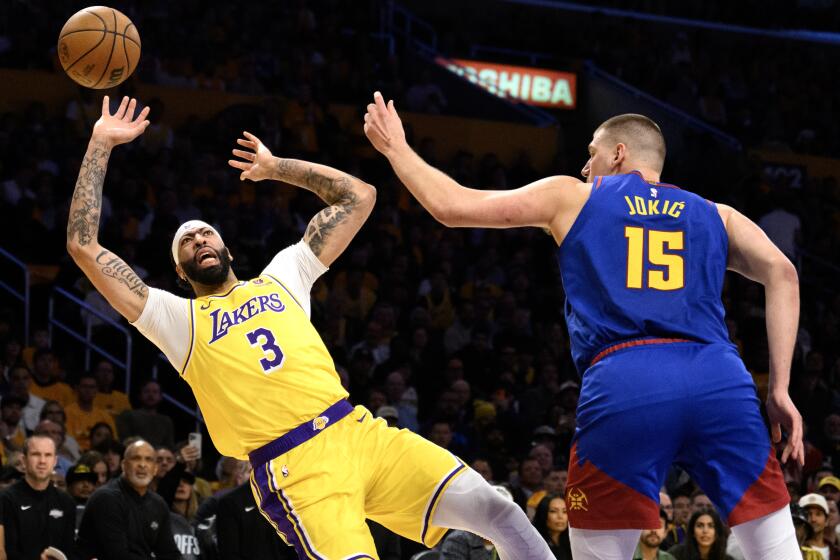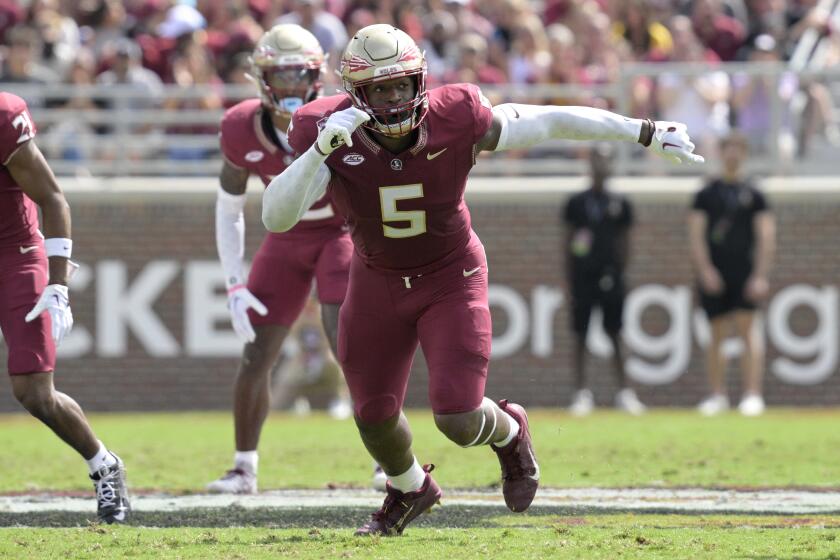For trainer Bill Spawr, horse racing has been a lifelong passion
Watching horse trainer Bill Spawr at work is a reflection of everyone who rises each day dedicated to a career they would like to think will one day provide a significant measure of satisfaction.
Spawr, 72, has spent more than 50 years trying to make sense of horse racing. None of his horses has won a Triple Crown, and his best showing in a Breeders’ Cup was fourth place.
Yet, every day at the fall meeting at Santa Anita Park, he was inside his barn at 3:15 a.m.
And Saturday, the veteran trainer sends out 5-year-old gelding Amazombie as one of the favorites in the $1-million Breeders’ Cup sprint race at Churchill Downs in Louisville, Ky.
“I’ve learned some of the answers, but you never get to know them all, because horses are individuals,” Spawr said last week in his wooden barn at Santa Anita that houses 32 animals. “It’s a crazy business.”
Spawr’s interest in the craft began while being raised in Downey, where he was a halfback on Downey High’s 1956 and 1957 CIF championship teams. He worked as a night-shift stock boy at a liquor store, and after the work was done Spawr would scour the Daily Racing Form.
“I was fascinated with these horses. What made them tick? What made them win?” he said.
A neighbor invited Spawr to Santa Anita. There, Spawr landed a blacksmith’s assistant job, holding horses while they were shoed and asking questions. He later went to work for veterinarian Robert Baker.
“I basically created a job for myself, because [Baker] would do his surgeries at night, then have to catch up later the next day about who needed what done,” Spawr said. “I started going around the barns in the mornings [for him]. I did that for 14 years.”
Baker then opened an equine hospital in Chino, and Spawr managed it, watching the surgeries to study how a horse was put together and to understand the effect racing had on thoroughbreds.
“I’ve seen things about a horse some of these [other trainers] will never see,” he said.
Spawr assisted trainer Joe Manzi, a former assistant to Hall of Fame trainer Charlie Whittingham, gaining insight from both men and celebrating victories such as when actor Rod Steiger’s horse Stained Glass upset the favorite, Telly’s Pop, owned by actor Telly Savalas. Steiger took the training staff out to dinner that night, remaining in character as funnyman W.C. Fields.
“Will never forget that night,” Spawr said.
By the late 1980s, Spawr trained on his own. He cultivated his own system of spotting horse talent and aiming to make his horses as comfortable in their surroundings as possible.
His admirers include legendary jockey Laffit Pincay, who describes Spawr’s effort as “a life given to racing.”
“The reason I start so early [in the morning] is to study their habits,” Spawr said. “These are the training hours.”
Last week Spawr was busy helping his “project” horses through a variety of training techniques. He took a nervous horse out to the track in darkness to “calm him with no activity out there, show him it’s not a bad place.”
He beamed at the victory of 2-year-old filly Ismene a day earlier, noting how he fixed the horse’s overexcited pre-race demeanor by tossing a highway cone and two workout balls into her stall.
“So content now,” Spawr said. “Like giving her a pacifier.”
Years ago, a horse Spawr claimed for $16,000 had a similar excitement issue called “stall walking” that was causing excessive weight loss. So he picked out the smallest stable he had. The horse couldn’t turn around inside it, ate like a king and began to win races.
To his “star,” Amazombie, he fed yogurt.
“It’s good for the stomach, digestion,” Spawr said as the horse calmly lapped up the feeding.
Tom Sanford, who co-owns Amazombie with Spawr, said his longtime friend’s “knowledge” after half a century is what sets him apart from peers.
“He’s not a salesman, he’s a horseman. No trainers do the legwork he does,” Sanford said.
Part of Spawr’s routine is to check on yearlings and racehorses recovering from injuries at a farm in Hemet.
It was on one of those visits in 2009 that a manager showed him two horses who were recovering from hind-leg tibia fractures. The manager wanted Spawr to name his price, but the trainer said he didn’t have too much cash.
“It’s cold outside, like 34 degrees, we both have hoods on,” Spawr said. “I said, ‘I can give you $5,000 for ‘him.’ ”
The manager thought Spawr had said “them” and approved the purchase, later calling Spawr to inform him “they” would arrive at Spawr’s barn the next day.
“Them?” Spawr said.
“Yes. Them. Both horses,” the manager said.
The next day, a horse that has turned out to be just average, Smoke No More, entered Spawr’s barn.
Then came the second horse, Amazombie.
Amazombie qualified for the Breeders’ Cup by winning the Oct. 9 Ancient Title Stakes at Santa Anita over Bob Baffert’s The Factor.
Spawr’s saddled 25 horses this meeting at Santa Anita, winning five races and collecting $296,790 for owners, about half of what the circuit’s most productive trainer has earned.
“Financially, winning the Breeders’ Cup would be nice, just to say I finally won it,” Spawr said. “When you own them yourself, you can be as patient as you want. I’ve been more patient with Amazombie, given him more individual attention. I’m happy with how it’s turned out.”
twitter.com/latimespugmire
More to Read
Get our high school sports newsletter
Prep Rally is devoted to the SoCal high school sports experience, bringing you scores, stories and a behind-the-scenes look at what makes prep sports so popular.
You may occasionally receive promotional content from the Los Angeles Times.







